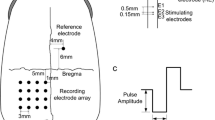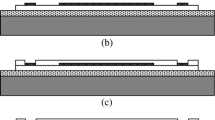Abstract
The Chinese C-Sight team aims to restore vision to blind patients by means of stimulating the optic nerve with a penetrating microelectrode array. A biocompatible, implantable microwire array was developed having four platinum-iridium shafts, each 100 μm in diameter. This penetrating microwire array is described in this paper, including its fabrication techniques and its in-vitro electrical characteristics. Every set of four shafts was spaced 0.4mm from center to center, comprising two short shafts that were 0.3mm long and two that were 0.9mm long. This design was intended to stimulate ganglion cell axons at different depths within the optic nerve. In-vitro electrochemical impedance testing results showed that the impedance at 1 kHz ranged from 8 to 10 kΩ at room temperature. The voltage responses of the arrays to current pulse stimulation indicated a charge-injection capacity of 210 μC/cm2. Finally, in-vivo acute animal experiments showed that the amplitude of the electrically evoked potentials (EEPs) measured in primary visual cortex could be as large as 100 μV upon direct stimulation of the optic nerve.
Similar content being viewed by others
References
Dobelle W H, Mladejovsky M G. Phosphenes produced by electrical stimulation of human occipital cortex, and their application to the development of a prosthesis for the blind [J]. The Journal of Physiology, 1974, 243(2): 553–576.
Troyk P, Bak M, Berg J, et al. A model for intracortical visual prosthesis research [J]. Artificial Organs, 2003, 27(11): 1005–1015.
Chow A Y, Chow V Y. Subretinal electrical stimulation of the rabbit retina [J]. Neuroscience Letter, 1997, 225(1): 13–16.
Zrenner E, Miliczek K D, Gabel V P, et al. The development of subretinal microphotodiodes for replacement of degenerated photoreceptors [J]. Ophthalmic Research, 1997, 29(5): 269–280.
Humayun M S, Weiland J D, Fujii G Y, et al. Visual perception in a blind subject with a chronic microelectronic retinal prosthesis [J]. Vision Research, 2003, 43(24): 2573–2581.
Rizzo J F, Wyatt J, Loewenstein J, et al. Methods and perceptual thresholds for short-term electrical stimulation of human retina with microelectrode arrays [J]. Investigative Ophthalmology and Visual Science, 2003, 44(12): 5355–5361.
Veraart C, Raftopoulos C, Mortimer J T, et al. Visual sensations produced by optic nerve stimulation using an implanted self-sizing spiral cuff electrode [J]. Brain Research, 1998, 813(1): 181–186.
Brelen M E, Duret F, Gerard B, et al. Creating a meaningful visual perception in blind volunteers by optic nerve stimulation [J]. Journal of Neural Engineering, 2005, 2(1): 22–28.
Sakaguchi H, Fujikado T, Fang X Y, et al. Transretinal electrical stimulation with a suprachoroidal multichannel electrode in rabbit eyes[J]. Japanese Journal of Ophthalmology, 2004, 48(3): 256–261.
Fang X Y, Sakaguchi H, Fujikado T, et al. Direct stimulation of optic nerve by electrodes implanted in optic disc of rabbit eyes [J]. Graefe’s Archive for Clinical and Experimental Ophthalmology, 2005, 243(1): 49–56.
Weiland J D, Liu W, Humayun M S. Retinal prosthesis [J]. Biomedical Engineering, 2005, 7(1): 361–401.
Pernkopf W, Sagl M, Fafilek G. Applications of microelectrodes in impedance spectroscopy [J]. Solid State Ionics, 2005, 176(25–28): 2031–2036.
Merrill D R, Bikson M, Jefferys J G R. Electrical stimulation of excitable tissue: Design of efficacious and safe protocols [J]. Journal of Neuroscience Methods, 2005, 141(2): 171–198.
Geddes L A. Historical evolution of circuit models for the electrode-electrolyte interface [J]. Annals of Biomedical Engineering, 1997, 25(1): 1–14.
Weiland J D, Anderson D J, Humayun M S. In vitro electrical properties for iridium oxide versus titanium nitride stimulating electrodes [J]. IEEE Transations on Biomedical Engineering, 2002, 49(12): 1574–1579.
Walter P, Heimann K. Evoked cortical potentials after electrical stimulation of the inner retina in rabbits [J]. Graefe’s Archive for Clinical and Experimental Ophthalmology, 2000, 238(4): 315–318.
Nadig M N. Development of a silicon retinal implant: Cortical evoked potentials following focal stimulation of the rabbit retina with light and electricity [J]. Clinical Neurophysiology, 1999, 110(9): 1545–1553.
Fang X, Sakaguchi H, Fujikado T, et al. Direct stimulation of optic nerve by electrodes implanted in optic disc of rabbit eyes [J]. Graefe’s Archive for Clinical and Experimental Ophthalmology, 2005, 243(1): 49–56.
Brummer S B, Robblee L S, Hambrecht F T. Criteria for selecting electrodes for electrical stimulation: Theoretical and practical considerations [J]. Annals of the New York Academy of Sciences, 1983, 405(1): 159–171.
Author information
Authors and Affiliations
Corresponding author
Additional information
Foundation item: the National Natural Science Foundation of China (Nos. 30700217 and 60971102) and the National Basic Research Program (973) of China (Nos. 2011CB707502 and 2011CB707505)
Rights and permissions
About this article
Cite this article
Sui, Xh., Shao, Yb., Li, Lm. et al. In-vitro and in-vivo electrical characteristics of a penetrating microelectrode array for optic nerve electrical stimulation. J. Shanghai Jiaotong Univ. (Sci.) 16, 614–619 (2011). https://doi.org/10.1007/s12204-011-1198-0
Received:
Published:
Issue Date:
DOI: https://doi.org/10.1007/s12204-011-1198-0
Key words
- optic nerve visual prosthesis
- platinum-iridium (Pt/Ir) microelectrode
- charge injection capacity
- impedance




